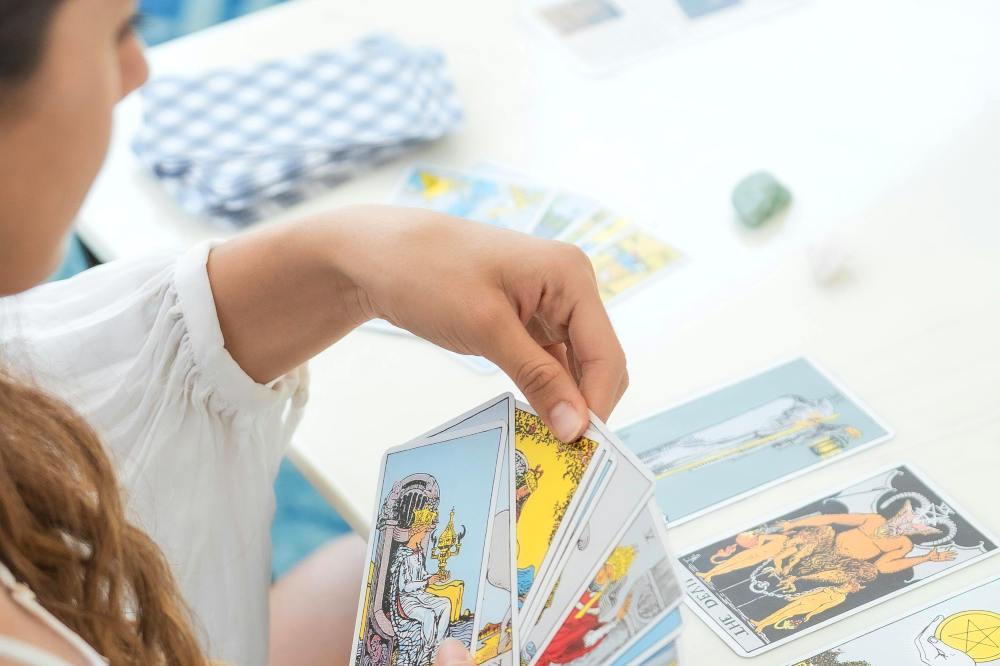
Tarot cards have fascinated people for centuries. With mysterious symbols, evocative artwork, and ties to the occult, they have often been viewed with suspicion. Some see them as tools of self-discovery and guidance, while others associate them with danger, superstition, or even evil. So, are tarot cards dangerous to use? The answer depends on how they’re used, what you believe, and the context in which they are practiced. This article explores the perceived dangers—psychological, spiritual, and social—as well as the benefits, myths, and safe practices surrounding tarot.
Panaprium is independent and reader supported. If you buy something through our link, we may earn a commission. If you can, please support us on a monthly basis. It takes less than a minute to set up, and you will be making a big impact every single month. Thank you!
What Are Tarot Cards?
Tarot cards are a deck of 78 cards used for divination, meditation, and introspection. The deck is divided into two parts:
-
Major Arcana (22 cards): Represent major life events or themes (e.g., The Fool, Death, The Lovers).
-
Minor Arcana (56 cards): Similar to a standard deck with four suits (Cups, Pentacles, Swords, Wands), focusing on day-to-day matters.
While tarot’s exact origins are debated, historians generally agree that tarot began as a card game in 15th-century Europe. It wasn’t until the 18th century that tarot became associated with mysticism and fortune-telling.
Common Fears About Tarot Cards
Tarot cards are often surrounded by fear and stigma, especially in conservative or religious circles. These fears generally fall into three categories:
1. Spiritual Danger
Some believe tarot cards open portals to dark forces or demonic entities. This concern is particularly prevalent in Christian communities, where divination is often labeled as sinful or satanic. Passages from the Bible such as Deuteronomy 18:10–12 warn against divination and “consulting with spirits,” leading many to view tarot as spiritually dangerous.
However, not all practitioners view tarot as a spiritual tool in a supernatural sense. Many see it as a psychological mirror rather than a means of contacting spirits. There's no scientific evidence that tarot cards summon entities or tap into otherworldly realms unless one is predisposed to believe that.
2. Psychological Harm
A more grounded concern is that tarot can cause anxiety, obsession, or delusion. Some users become overly reliant on readings, using them to make every decision—from relationships to finances—rather than thinking critically or seeking professional guidance.
A 2019 study published in the Journal of Spirituality in Mental Health noted that for some individuals, divination practices like tarot may contribute to increased anxiety if not balanced with rational thinking. Self-fulfilling prophecies can occur if someone becomes convinced of a negative outcome.
3. Fraud and Manipulation
Some tarot readers exploit vulnerable people by charging high fees or making dramatic claims. Tactics like telling clients they are cursed and offering expensive “cleansing rituals” are not only unethical but can cause psychological and financial harm.
This is not an issue with tarot cards themselves but rather with dishonest practitioners. As with any field, there are trustworthy professionals and bad actors.
Is There Any Evidence of Danger?
There is no scientific proof that tarot cards themselves are dangerous. They are pieces of paper with artwork. The danger lies in how they are used and how seriously people take them.
The American Psychological Association does not list tarot as inherently harmful but notes that any tool used in place of professional mental health care can be problematic, especially if someone is dealing with trauma, psychosis, or severe depression.
In rare cases, individuals with certain mental health conditions may interpret tarot messages in harmful ways. For example, someone with paranoid delusions may believe the cards are "warning them" about plots or danger. This risk is not unique to tarot—it also applies to dreams, horoscopes, or even religious texts when interpreted without grounding in reality.
When Tarot Can Be Helpful
Many people use tarot not as a supernatural oracle, but as a tool for self-reflection, introspection, and creative thinking. Here are a few examples:
1. Therapeutic Use
Some therapists incorporate tarot into sessions to help clients explore unconscious thoughts, archetypes, or personal narratives. Known as tarot therapy, this practice uses the symbolic nature of the cards to prompt discussion, similar to how Rorschach inkblot tests are used.
A 2021 study in the Journal of Humanistic Psychology found that symbolic tools like tarot can enhance narrative therapy by helping clients express emotions in a non-threatening, metaphorical way.
2. Creative Inspiration
Writers, artists, and musicians often use tarot cards to spark ideas. Drawing cards like “The Tower” or “The Empress” may inspire characters, themes, or visual imagery. The randomness and symbolism of tarot encourage people to think outside the box.
3. Decision-Making and Reflection
Tarot can help clarify feelings about a situation by offering new perspectives. It doesn't predict the future with certainty but can highlight patterns or options one might not have considered. This process can be empowering rather than deterministic.
Myths About Tarot Cards
Let’s examine and debunk a few common myths that contribute to the idea that tarot is dangerous.
Myth #1: Tarot cards can curse you.
There is no evidence that tarot cards have inherent power to curse or harm you. They are tools—like mirrors or journals. If someone feels cursed after a reading, it’s likely due to suggestion or anxiety, not the cards themselves.
Myth #2: You should never buy your own tarot deck.
This is a superstition, not a fact. Many seasoned readers buy their own decks and feel a deep connection to them. The idea that you must receive a deck as a gift has no bearing on its safety or effectiveness.
Myth #3: Tarot always predicts the future.
Tarot is not a crystal ball. While some believe it can offer glimpses of potential outcomes, most modern readers emphasize possibilities, free will, and personal agency. A reading reflects your current energy, not a fixed destiny.
Myth #4: You have to be psychic to read tarot.
Anyone can learn to read tarot. While some readers claim intuitive or psychic abilities, most rely on symbolism, psychology, and storytelling. The “danger” often associated with tarot arises when people place blind faith in so-called psychic authority figures without critical thinking.
Safe Practices for Using Tarot
To minimize potential dangers and maximize benefits, consider these best practices:
1. Keep it Grounded
Remember, tarot is a tool—not a magical answer to life’s problems. Use it for reflection, not rigid decision-making. If you’re struggling with serious life issues, consult appropriate professionals.
2. Avoid Overuse
Doing too many readings in a short time can lead to confusion or obsession. Give space for your intuition and daily experience to guide you.
3. Be Mindful of Mental Health
If you’re feeling anxious, paranoid, or depressed, tarot might not be the right tool. Avoid interpreting the cards as literal predictions or warnings.
4. Vet Readers Carefully
If you’re getting a reading from someone else, research them first. Avoid anyone who makes extreme claims, charges high fees, or tries to scare you into coming back.
5. Set Clear Intentions
Before doing a reading, ask yourself: What am I hoping to explore or understand? Clear questions lead to clearer insights.
What Do Different Belief Systems Say?
Christianity
Many Christians view tarot as a form of divination condemned in the Bible. However, not all Christians interpret scripture the same way. Some liberal theologians see tarot as a form of storytelling or inner dialogue rather than occultism.
New Age and Pagan Beliefs
Many New Age and Pagan practitioners embrace tarot as a spiritual tool that connects them to inner wisdom, deities, or universal energy. In these communities, tarot is not seen as dangerous but as sacred and meaningful.
Skeptical and Secular Viewpoints
Skeptics often view tarot as pseudoscience or entertainment. Still, many acknowledge its psychological value when used metaphorically. As long as users are aware that the cards are symbolic—not magical—there’s little risk involved.
Conclusion: Are Tarot Cards Dangerous?
Tarot cards are not inherently dangerous. They are symbolic tools, and like any tool, their impact depends on how they are used and interpreted. While there are risks—especially if used obsessively, manipulatively, or in place of professional help—there are also meaningful benefits when approached with intention and balance.
The key is critical thinking. If you approach tarot with curiosity, respect, and self-awareness, it can serve as a powerful mirror for reflection and growth—not a source of fear.
Was this article helpful to you? Please tell us what you liked or didn't like in the comments below.
About the Author: Alex Assoune
What We're Up Against
Multinational corporations overproducing cheap products in the poorest countries.
Huge factories with sweatshop-like conditions underpaying workers.
Media conglomerates promoting unethical, unsustainable products.
Bad actors encouraging overconsumption through oblivious behavior.
- - - -
Thankfully, we've got our supporters, including you.
Panaprium is funded by readers like you who want to join us in our mission to make the world entirely sustainable.
If you can, please support us on a monthly basis. It takes less than a minute to set up, and you will be making a big impact every single month. Thank you.































0 comments